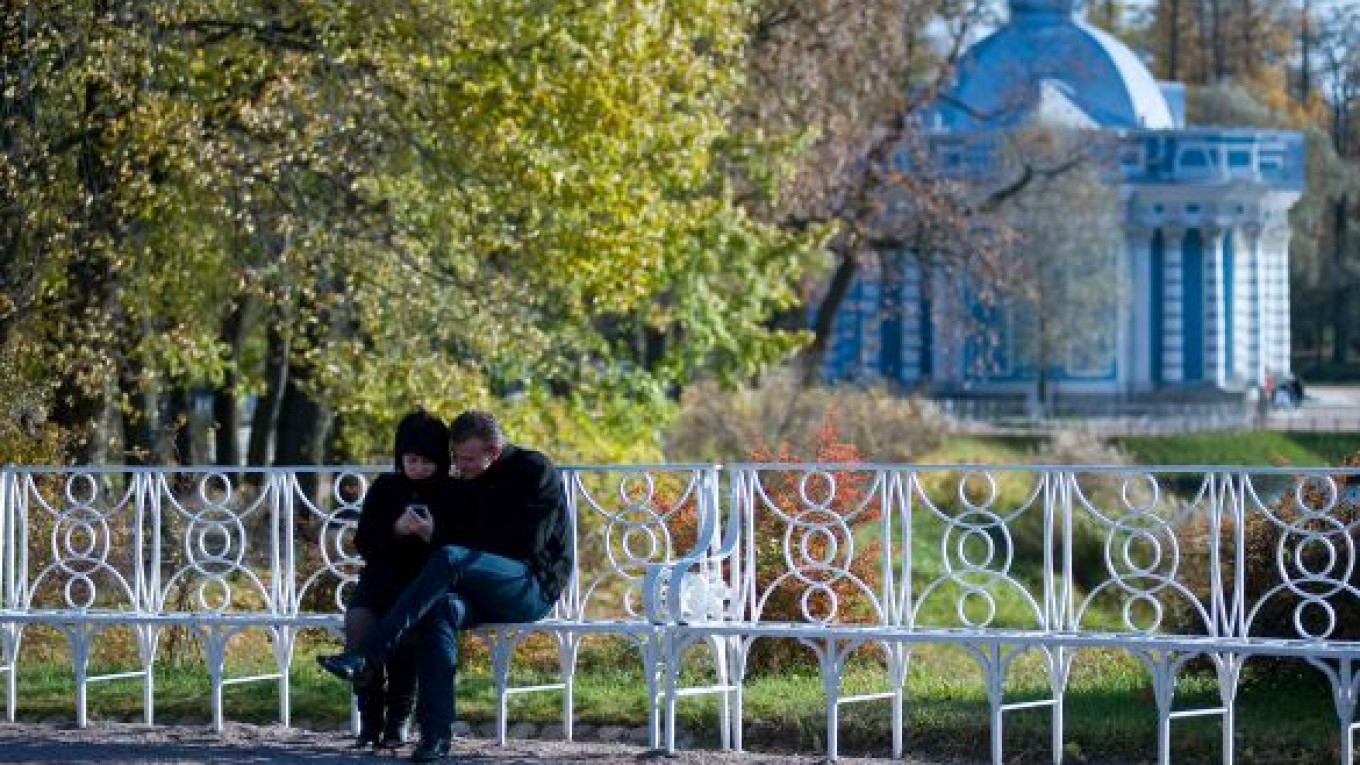TSARSKOYE SELO, Leningrad Region — Tsarskoye Selo, the summer residence of the tsars located 25 kilometers to the south of St. Petersburg in the town of Pushkin, has always been a popular daytrip option among visitors to St. Petersburg, and with the completion of major renovation work in time for the estate’s 300th anniversary celebrations this year, the “village of the tsars” has become an even more appealing destination, even for seasoned visitors.
The 300-hectare palace-and-park ensemble is composed of two parts: the Catherine Park and the Alexander Park, with more than a hundred historical landmarks — palaces, pavilions and bridges — scattered across their grounds. The estate, which was developed as a grand imperial residence over the course of two centuries, has a turbulent history. Turned into a museum after the October Revolution of 1917, it suffered devastating damage during World War II, for a long period of which the premises were occupied by German troops. The daunting task of restoring the estate to its original appearance was decided upon in the 1950s, and reconstruction work has been ongoing ever since.
“The 300th anniversary is an occasion to discuss and think about the historical heritage we represent,” said Olga Taratynova, Tsarskoye Selo’s director. “Tsarskoye Selo is undeniably a very special place. It was the capital of Russia for many summers. Nicholas I, Alexander II and Nicholas II loved spending the warmer months in the residence, and many governmental issues were taken care of here. It is also a unique encyclopedia of park architecture, with examples of English, Dutch and French landscapes, among others, and a catalogue of very diverse architectural influences.
“The celebrations also had a huge impact on renovation work. With that date in sight, we were able to complete the restoration of the church domes, the Arabesque Hall and main courtyard facade of the Catherine Palace, the Hermitage Pavilion, the Turkish Bath, the Lower Bathhouse and the Concert Hall, as well as parts of the Alexander Palace and several bridges,” Taratynova added.
The highlight of the list of restored items is surely the Baroque mid-18th-century Hermitage Pavilion, opened to the public for the first time this summer. Such pavilions were a regular feature in 18th-century gardens. Generally located far from the main palace, they were designed to offer the owner of the estate a place to relax and dine with a few select guests, without the burden of etiquette entailed by entertaining in the main palace.
The Hermitage Pavilion hosts an intriguing mechanism that allowed the Russian rulers and their guests to be served without the presence of waiters. Dishes were raised from the ground floor to the dining room located on the first floor through shafts hidden under each table. The system also made it possible for whole tables to disappear through the floor after dinner, thus leaving the party with plenty of room to dance.
These quiet imperial evenings among friends necessitated the presence of 12 people to operate the lift system and, with the cooking taking place in another pavilion to avoid the inconvenience of odors, another 80 to manage the culinary part of the program.
Unfortunately, like all the other pavilions on the grounds, the Hermitage is closed in the winter because it is not heated. From October until May, when the weather allows tours to start again, visitors to the park will have to be content with a look at its exterior. But the pavilion’s interesting symmetry and the stunning perspective of the Catherine Palace from this spot are certainly worth it. The Hermitage also represents a good starting point for a stroll around Catherine Park, its romantic ponds and canals, and its many other landmarks, including the lovely salmon-colored Turkish Bath. In colder months, the main paths around the grounds are swept of snow, making walks around this fairy-tale winter wonderland possible. A visit to the grandiose Catherine Palace, the centerpiece of the ensemble and home to the legendary Amber Room, is a good way to warm up after such a promenade.
Another possibility, in contrast to the Baroque exuberance of Rastrelli’s Catherine Palace, is to head to the classical Alexander Palace, whose construction was completed by Rossi at the end of the 18th century. The residence was a summer dacha for the imperial family in the 19th century, but it became the home of the last tsar, Nicholas II, and his wife Alexandra during the last 13 years of their reign. It was from this palace that the Romanov family was sent into exile after the Revolution.
The moving exhibition “Reminiscences in the Alexander Palace,” housed in the partially preserved interiors of Nicholas II’s private apartments and featuring furnishings and personal belongings, gives a haunting impression of how the last Russian emperor and his family lived. This year, three newly restored staterooms — the Semi-Circular Hall, the Portrait Hall and the Marble Drawing-Room — were opened to the public. Much of the building remains in poor condition and is closed to visitors.
Alexander Park, which features only a few reconstructed items, including the gaudy, somewhat bizarre Chinese Village, represents a wilder and in some ways more charming alternative to Catherine Park. More spacious and consequently less crowded than its feminine counterpart, Alexander Park is the perfect place for those who want to enjoy some quiet time away from tourist coaches. But this might change in the near future, with the park and palace set to regain their past majesty.
“The renovation of the Alexander Park and Palace is our next challenge: About 70 percent of the work is ahead of us, but if we receive all the necessary financial support, it should take six to eight years,” Taratynova said.
Specifically, the next steps to be taken are the continuation of repair work in the Alexander Palace and the White Tower, the renovation of the park’s bridges, and the creation of a World War I museum in the Martial Chamber — a project the museum’s management hopes to complete in 2014, in time for the centenary commemorations of the start of the war.
Tsarskoye Selo also hopes to tackle the Equestrian Complex and the Imperial Farm. Currently under discussion is the establishment of a small zoo as a reminder that in the 19th century, the tsars used to keep animals such as llamas and elephants in part of the park.
And the estate’s director will make certain to bring all these novelties to the attention of the public.
“Some parts of the ensemble are rarely visited, which is a shame,” said Taratynova.
“Tourists often tend to rush straight to the Amber Room and not take the time to see the rest. Focusing on new objects is definitely one of the main directions we want to follow in the coming years.”
Tsarskoye Selo. 7 Sadovaya Ulitsa, Pushkin. Take Minibus 42, 545 from the Moskovskaya metro station to the Catherine Palace and Park, or take the suburban train to Detskoye Selo Station (town of Pushkin), then bus 371, 382 or minibus 371, 377, 382 to Catherine Palace and Park. Tel. (812) 465-9424. http://eng.tzar.ru
A Message from The Moscow Times:
Dear readers,
We are facing unprecedented challenges. Russia's Prosecutor General's Office has designated The Moscow Times as an "undesirable" organization, criminalizing our work and putting our staff at risk of prosecution. This follows our earlier unjust labeling as a "foreign agent."
These actions are direct attempts to silence independent journalism in Russia. The authorities claim our work "discredits the decisions of the Russian leadership." We see things differently: we strive to provide accurate, unbiased reporting on Russia.
We, the journalists of The Moscow Times, refuse to be silenced. But to continue our work, we need your help.
Your support, no matter how small, makes a world of difference. If you can, please support us monthly starting from just $2. It's quick to set up, and every contribution makes a significant impact.
By supporting The Moscow Times, you're defending open, independent journalism in the face of repression. Thank you for standing with us.
Remind me later.






